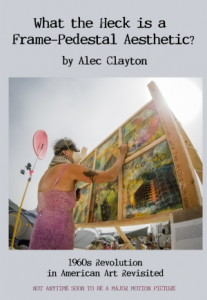
1960s Revolution in American Art Revisited
by Alec Clayton – It was 1970. For thousands of years, Western art had consisted of pictures on walls and sculptures on pedestals meant to be admired for their beauty – the frame-pedestal aesthetic. But in the 1950s and 1960s there was a profusion of new and different happenings in the world of visual art that in many ways ended what art critics and historians had written about as an orderly, chronological evolution of European and American art beginning roughly with the Italian Renaissance and reaching its zenith with the Abstract Expressionists in New York.
Alec Clayton’s 1970 graduate thesis at East Tennessee State University with the academic-sounding title, A Ground for the New Art: An Alternative to the Frame-Pedestal Aesthetic, analyzed what many at the time called the new art.
This book is that thesis with a new title and updated materials. It is an examination of the multitude of new art forms that exploded on the scene in the 1960s, from Pop to Happenings to Color Field Painting to Earth Art to Photo-Realism to mail art and more.
Order What is What the Heck is a Frame-Pedestal Aesthetic? from your favorite bookstore or Amazon.
Publication years: 1970, 2020
Trade paper, 64 pages with color illustrations
$14.00 Amazon ISBN: 979-8664224030

Related blog posts by Alec Clayton:
Post-Postmodern Postscript to What the Heck is a Frame-Pedestal Aesthetic?
July 5, 2020
reassessing “the new art”
June 4, 2020

And playwrite Bertold Brecth breaking the confines of the stage.